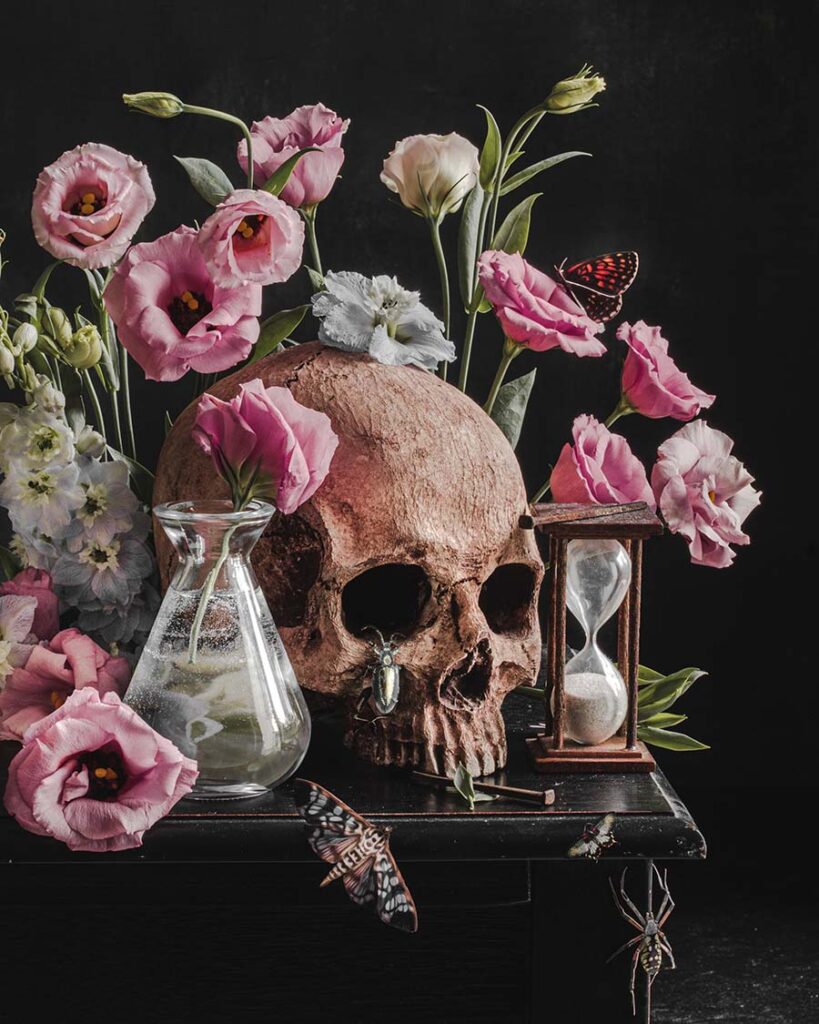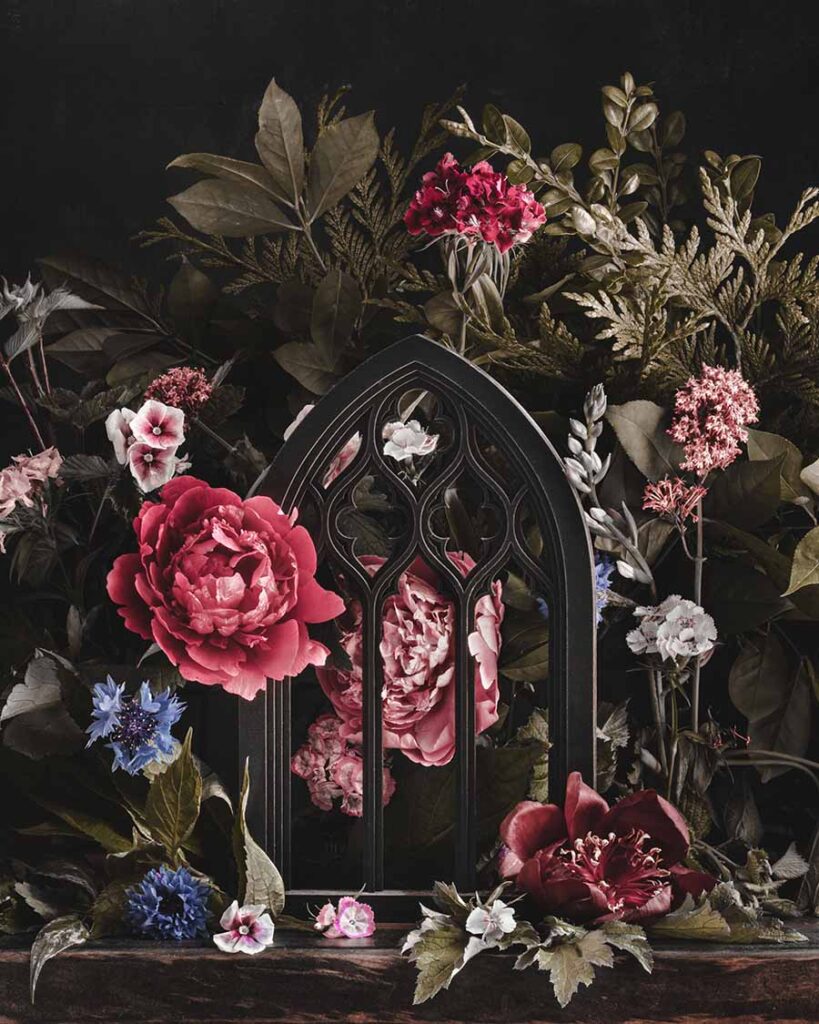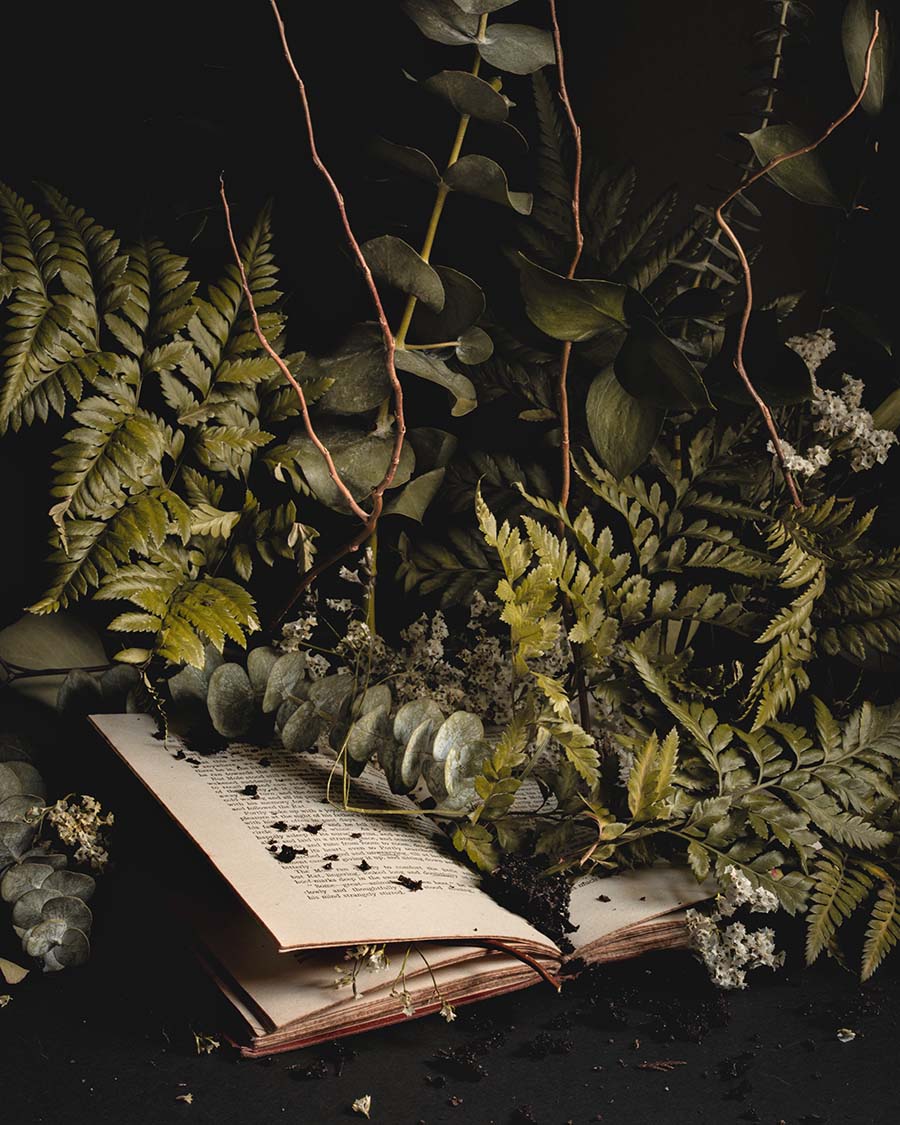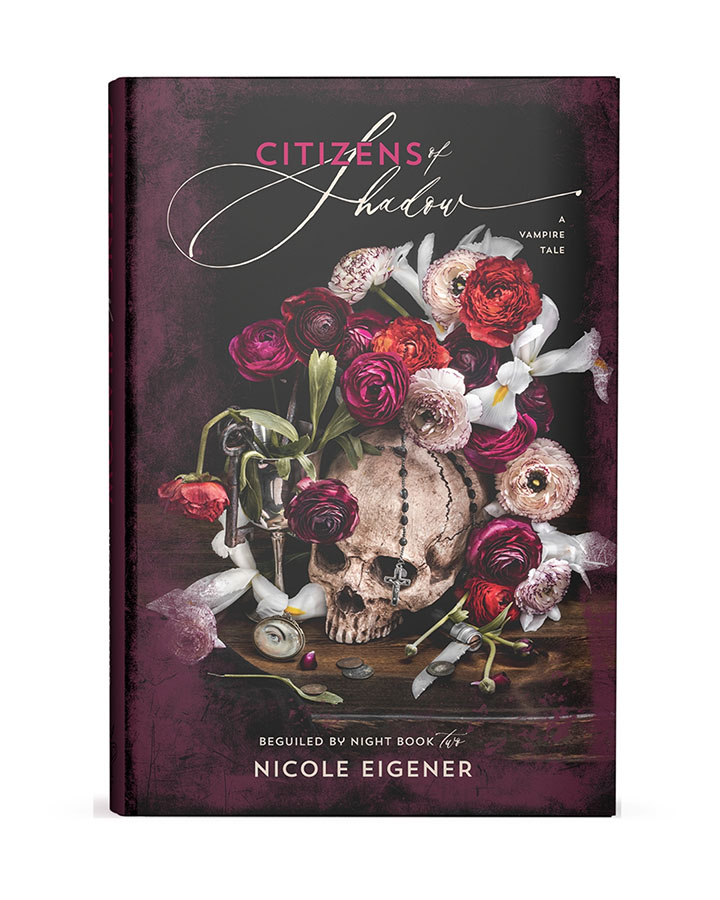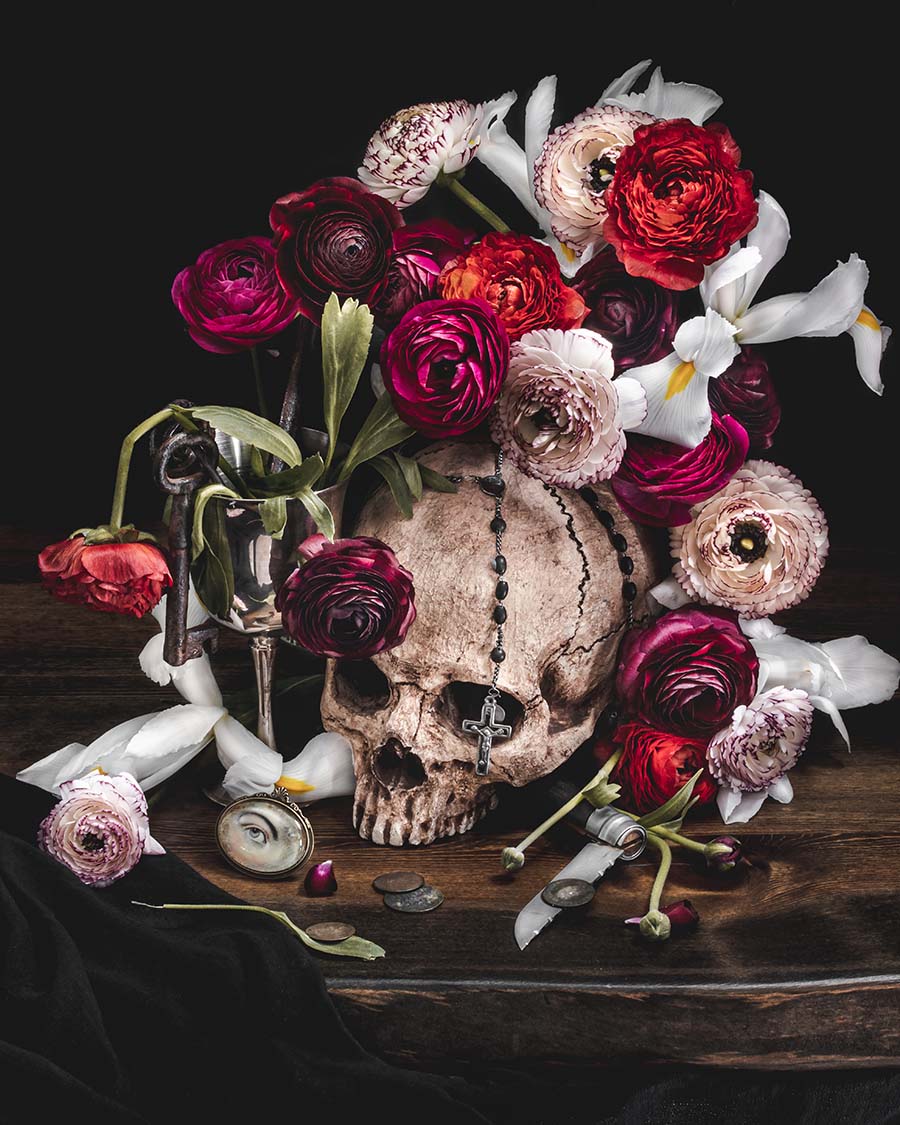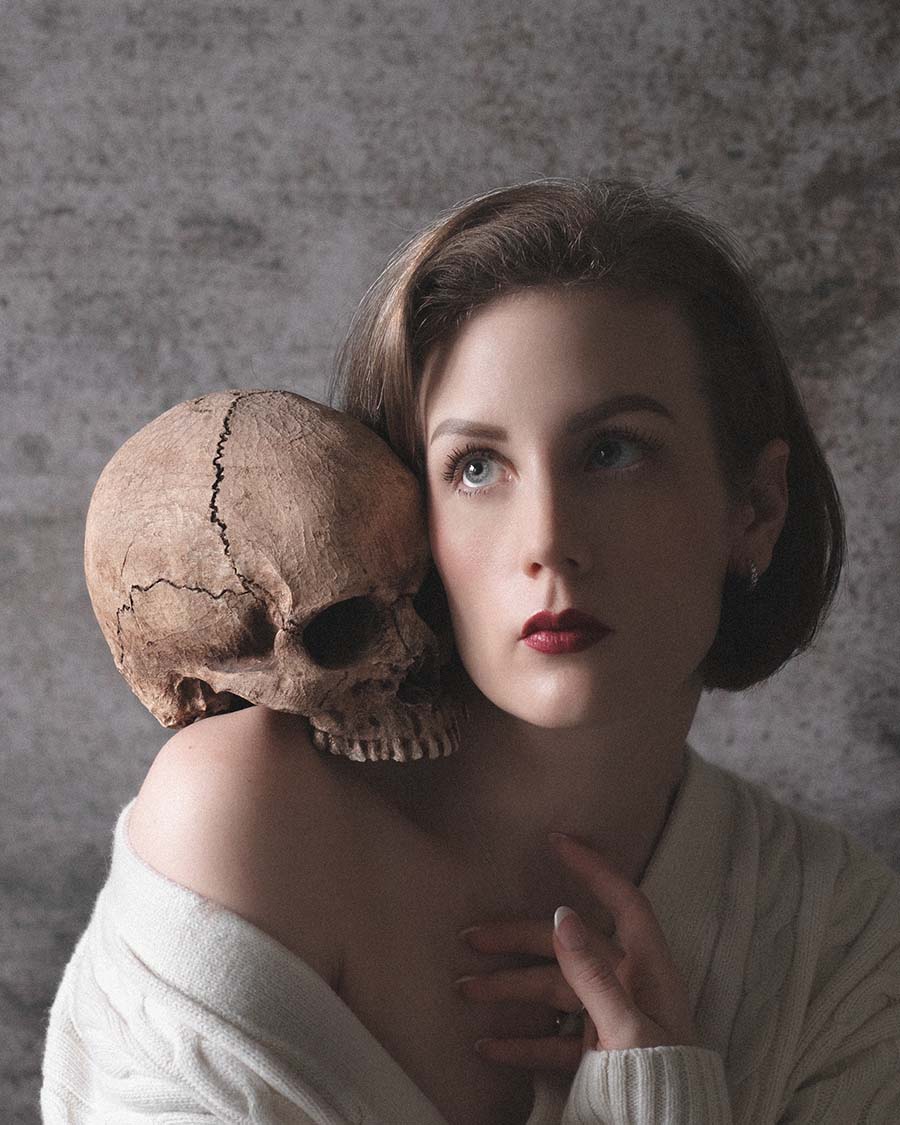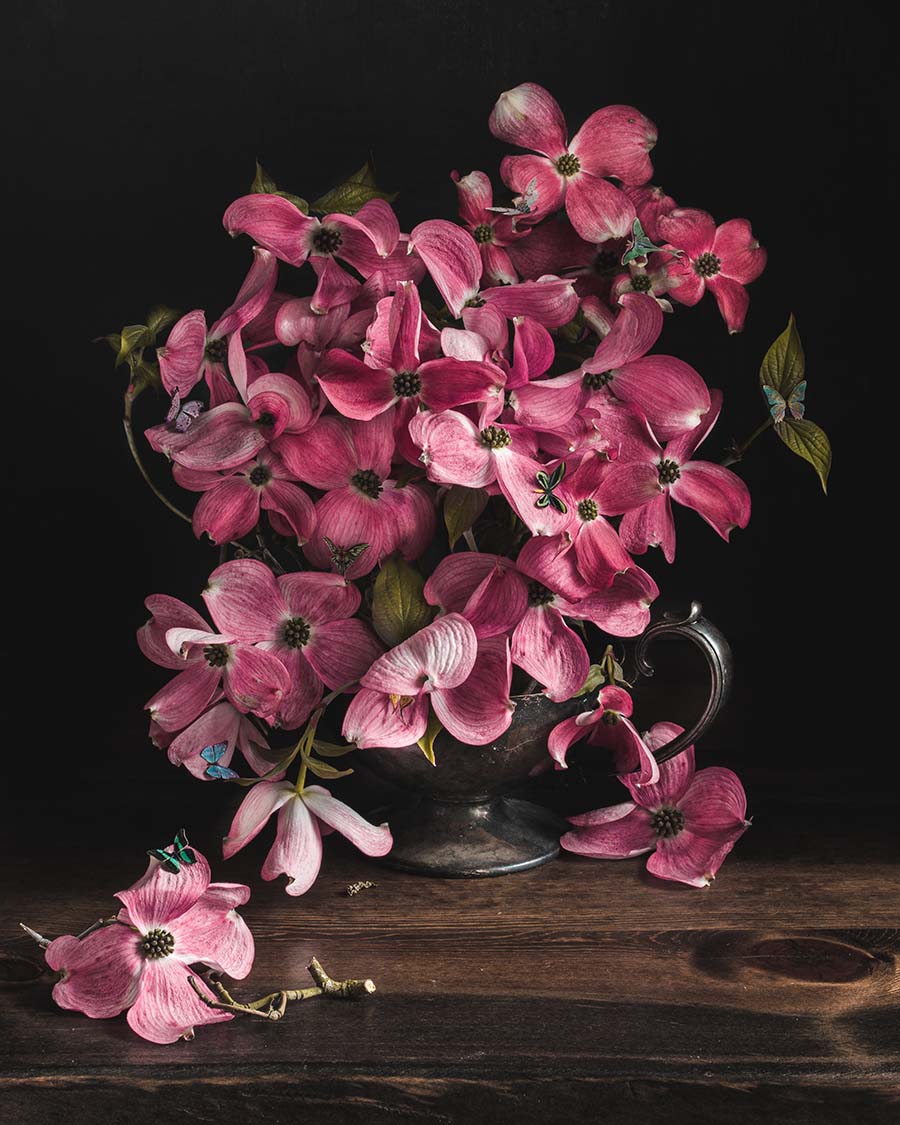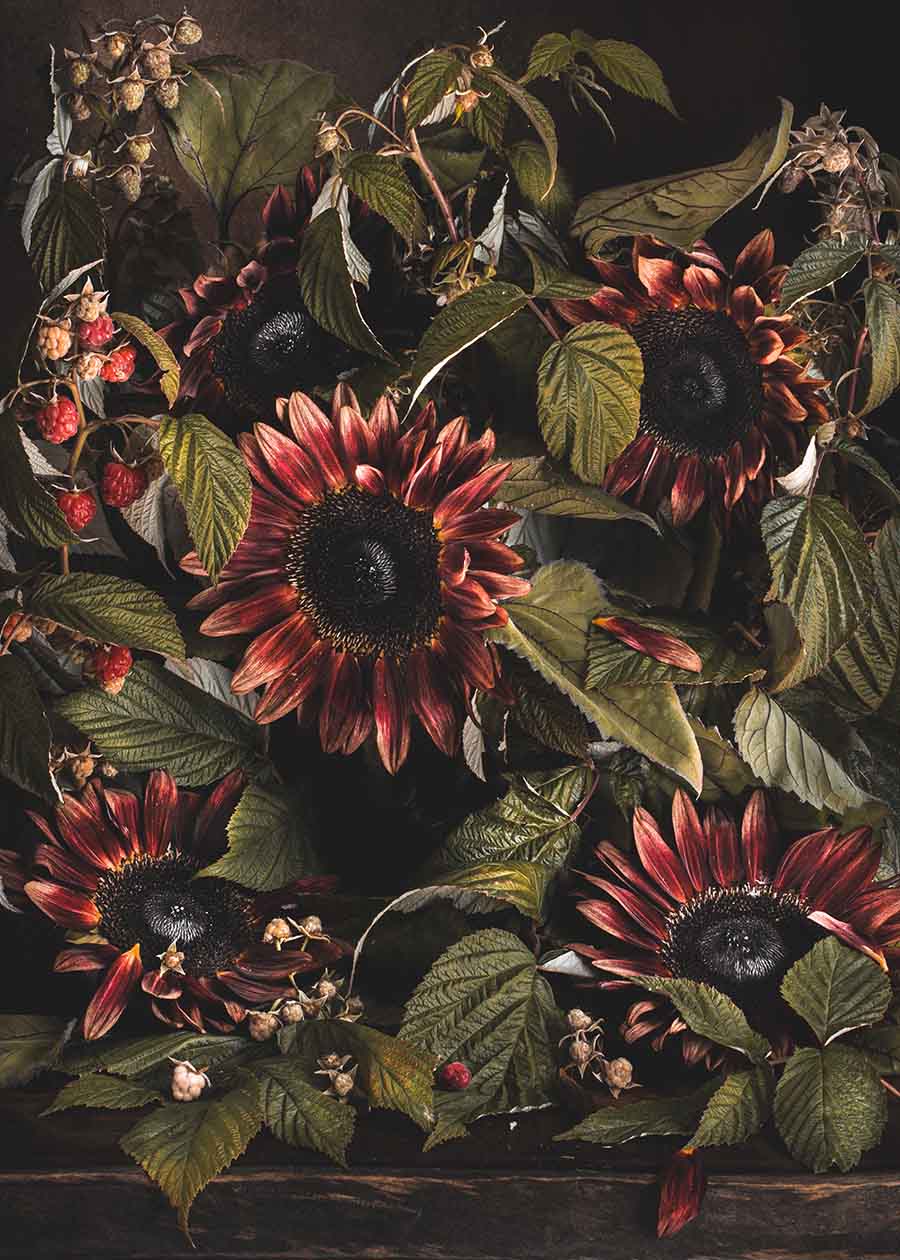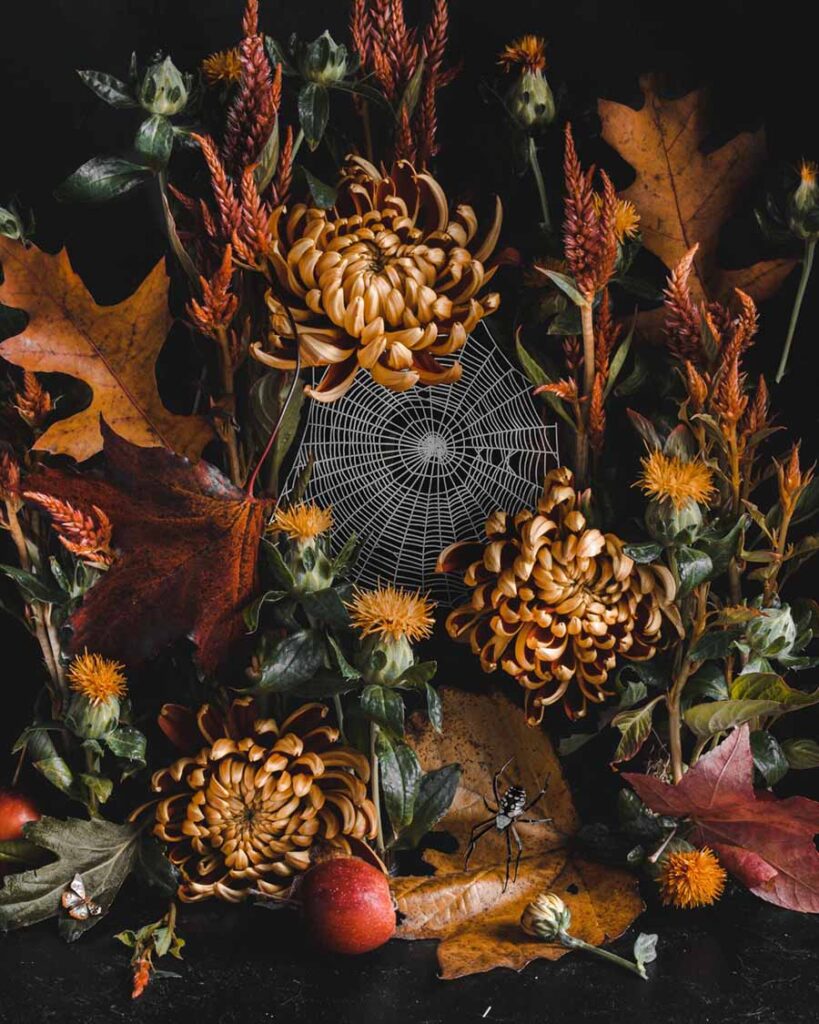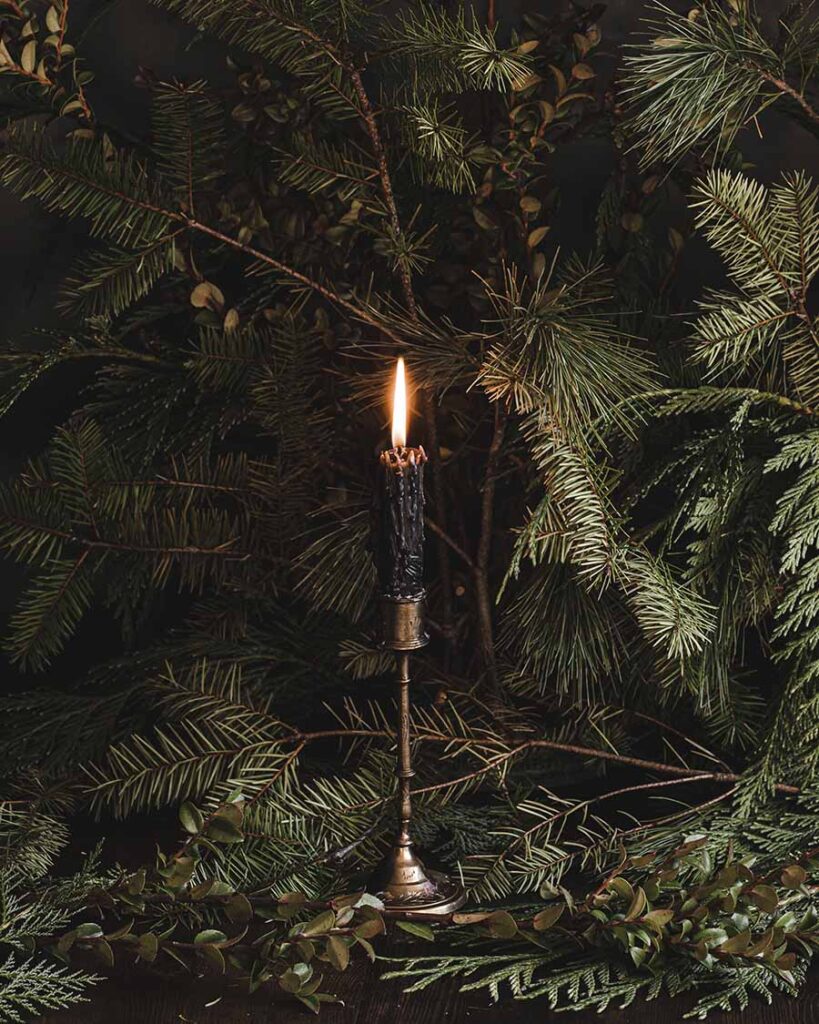As a child growing up in small-town Oregon, Alyssa Thorne seized every opportunity to draw and create, but it wasn’t until a trip to visit her art-enthusiast aunt in San Francisco that she realized art could be a career. She began her practice as a photographer with a single instant camera, which she used to document that very trip—a moment which would foreshadow her future as a fine art photographer with a style as unique as it is beguiling.
Thorne’s process is as intricate as the pieces she crafts: she writes out a loose statement for her visual pieces before she begins the process of creating them. She finds the right elements, sometimes waiting whole seasons for the proper blooms to come into play. Then, using an elaborately hand-crafted system of cardboard and reflectors, she photographs her subjects using only natural light to create a signature style that is at once Baroque and modern.
The subjects of her captivating work range from the gleeful to the macabre, frequently tip-toeing the line between birth and death, telling stories of the natural world and its constant cycles of renewal. The longer a viewer interacts with the piece, the more they may find—Thorne’s works draw on the legacy of the painters of the Renaissance and the Dutch Golden Age who perfected the art of subtle symbolism. If a picture is worth a thousand words, Alyssa Thorne’s are not just a jumble of adjectives, but whole stories caught up in the play of light and dark, color and its absence, objects man-made and naturally grown. In this exclusive interview, we’ll delve deep into her artistic process and find out what it has taken to bring about her own golden age of still life.
How did you get started as a fine art photographer? What drew you to the art of still-life?
My beginning in art didn’t start in photography, but I suppose I have always been artistically inclined. As a child, I was always drawing on any scrap of paper I could find. I picked up photography around the age of 15 when I took a disposable film camera to San Francisco with only the intent to document my trip. I was there to visit my wonderful aunt Jenny, who is a longtime art collector and enthusiast. Wandering her house as a young person was magical, as it was packed full of art I would never have seen otherwise as a pre-internet kid from an Oregon suburb. She has always been the #1 supporter of my art, and encouraged me every step of my career, from that first camera to college. Her support of working artists taught me that being an artist as a job was even possible to do in the first place.
After that first foray into life with a camera in hand, I fell deeply in love with how much more of my surroundings I seemed to see through the lens. I began to notice details I never had before. A camera was a magical device – time slowed to a standstill under my shutter, and the world rapidly unfolded for me. I continued learning photography through film courses in high school and then art college. I can still see that pure wonder in photos I took as a teenager. The newness and elation of having a tool to see the world the way I was meant to. A new, unknown universe had revealed itself, and I was ready for it.
A camera was a magical device – time slowed to a standstill under my shutter, and the world rapidly unfolded for me.
Before and during the beginning of college, I focused mostly on portraits, commercial work, and landscapes. Capturing the hidden parts of the world, of people and places. I studied art history alongside photography and quickly became obsessed with renaissance, baroque, and Dutch golden age art. I am an ardent lover of secrets and symbols, and each still life I researched contained so many multitudes. I was utterly awed. How can one table tell so many stories? I photographed still life only for myself as a kind of visual therapy diary, to work through my pain and celebrate my joy.
I thought they were a little old fashioned for people to want to see, so I did not show any publicly until the last few years. I have always done other art forms and kept them to myself. I draw regularly and have had a longstanding affair with sculpture, which informs my still life work a lot. In high school I even welded a flock of sculptures which my mother graciously kept in the garage. I say this, because unfortunately, they were very, very ugly. I decided, at a certain point, that still life (& the occasional self-portrait) was the only vehicle that could properly tell the stories I wanted to tell. I doubt that will ever change.
Once I started to post my still life, my art took off on social media more than it ever had before. At this point I absolutely do not see myself doing anything else photographically for a long time, if ever. My creativity is now deeply rooted in the very hands-on process of shaping and making the arrangements themselves. The thought of making photographs without that process feels very empty to me. Which is not to say that I don’t like making other types of photographs alongside the still lifes, it is just the core of my practice now to work this way.
What are some habits you’ve developed in your artistic practice that help you to stay inspired?
Taking breaks. Often when I am burnt out creatively, it’s due to having no time outside the studio doing what I enjoy or experiencing life.
I think the most helpful thing other than that is forming creative relationships. It can be so inspiring to see someone else at work and have the right space to discuss challenges and share triumphs in your practice. My good friend, the transcendent painter Elisa Vita, is always a refresh to my inspiration. We have a type of relationship that was previously unknown to me. We are somehow not only close friends, but also each other’s critique partner, teacher, mentor, moral support, cheerleader, proofreader, and more. Our talks are the safest place to discuss our wildest creative ideas. We have a similar way about us, with different ways of expression. Every artist has their own secret world, where they grow and pluck ideas. Ours just happen to border each other and we’ve given each other spare keys to visit.
Every artist has their own secret world, where they grow and pluck ideas. Ours just happen to border each other and we’ve given each other spare keys to visit.
What is your process for crafting a piece from start to finish?
After thinking of a concept for a new piece, I write a loose outline of my statement for it. Typically, I don’t write the whole thing beforehand, but knowing what I want to say with the image and the statement both, is important. I have been writing all my life, and believe that for me, my words and my photos are inseparable. They are a whole unit, interwoven so tightly that I rarely display full pieces without the statement. For others viewing my images, they may not read my words at all and gain something else from the piece. That is encouraged, because art is personal, and meant to evolve beyond its creator. If what it means to you wasn’t the creator’s intent, it’s still meaningful isn’t it?
After creating the outline, I do any research that I need to make a list of props and possible floral options – if there is a particular need, sometimes I must wait til the right season to shoot. I shop for props once I am ready to start putting the piece together. A lot of the props are my own belongings, sentimental heirlooms etc. Otherwise, I thrift locally with a list in hand, or source items through Roses & Rue Antiques.
Once I have props, I sketch a loose composition, which often changes during the shoot. I frequently do test shoots on the props to see if there are any difficulties with my lighting or composition. Then comes the actual shoot, which takes a few hours to do. I use only natural light and a rather robust cardboard flagging and reflector system. After that I edit, and that can take 3-12 hours depending on the piece. Over a span of a week to 6 months, depending on how easy it is for me to decide on the color grading. Then I finish the statement and release it!
What are some common elements you find yourself drawn to time and time again? What do those symbolize for you?
I love my symbols! A lot of people still have this attitude that still life work is boring, but I think with the right curiosity, it can be interesting to anyone. Objects can be so multifaced in what they represent. It’s all way beyond just being an object on a table. A single petal can be a whole world. Historically, it was often a picture of the culture and state of the world at the time. Elements in classical still life represented everything from vanity, and the fleeting nature of the human lifespan, to trade routes, transformation, and divinity. Reflections can be seen in glasses, platters, and other mirrored surfaces – if you look close enough at a reflective object in a classical still life, you’ll see windows, doors, the artist themselves, and other things. Some still life even contain windows that look out to a larger world. Which may be a little hint at a piece I am currently working on. :)
As for my favorites, I love using (faux) skulls! I have always had an affinity for both death & time symbolism like candles, hourglasses etc., but skulls are my favorite. My skull is a carved and painted foam replica, I’ve named her Francis, and my community seems to find that as funny as I do. Francis has starred in a large number of my works, most recently in one of my favorite commissions for my friend Nicole Eigener’s book cover. The book, – “citizens of shadow”, is the second book in her series about a queer, French, time-traveling vampire. I absolutely jumped at the chance to do the cover, of course, and being that a vampire is the main character, death is obviously a theme. She sent me some artifacts that her character uses in the book, and it was one of the most unique and fun commission pieces I have ever made.
On a more serious note, I use skulls and death imagery so much, as my earliest still life works were created to work out grief and trauma I was experiencing. I was subject to a lot of loss in my early childhood. I still make a lot of work about these feelings. Death is not a taboo subject for me, and I think discussion of it needs to be normalized more. I believe strongly in death positivity – a movement dedicated to speaking more openly about death, to reduce stigmas around discussing dying & grief, impact end-of-life care. It is also a way to help the death care industry protect the environment through advocating for more eco-friendly and accessible practices. Death positivity empowers us to question systems, laws, socioeconomic divides, and the inequalities of racial, gender, and sexual orientation etc, that result in unnecessary death.
Your craft often rotates with the seasons, using elements and colors that represent the tonality of the natural world. Do you have a favorite season? Do any inspire you more than others?
I work with what is available to me locally as far as florals, fruit etc., so I usually stick with a seasonal palette or visual theme, unless I am working on a piece for some time and end up releasing it late. I love working this way because it enables me to have constant change. I live in the pacific northwest, and I get the luxury of foraging around me for a lot of the things I use. Some of my pieces contain entirely or partially foraged materials like blackberry vine, cherry blossom, leaves etc. I don’t always buy flowers and plants. “Still Life with Dogwood” is my favorite. Every flower in this piece was taken from the dogwood outside my apartment.
How long do you spend setting up an individual still life? Do you take many images to get the one which you’ll ultimately use?
It often depends on if there are perishable elements, like flowers out of water. Generally, it takes about 2 hours, but sometimes it will go on a little longer if I have little or no florals and time to rearrange, or if it is a particularly large & intricate piece. I rearrange it as I go, and often end up with over 100 images to pare down from. I usually edit less than five, and one makes it as the piece. The other shots are details, up close, or videos that I post to social media so that viewers can see other angles, details, or how I shoot.
Are there any secrets to still life photography that amateurs might not know that you’re able to share?
As I mentioned, when detailing my process, it takes a very long time for me personally to create a new work. I am not sure my particular length of process is true for every still life artist, as we all have our own routines. I have spoken to many other artists in my community though, and we all are generally careful and detailed sorts of people. ALL still life takes a fair amount of time to craft. Viewers often think it is a matter of tossing flowers in a vase for a quick beautiful shot, but even my most quickly created photos with little to no concept, take hours. There is a lot of rearranging behind the scenes, and nothing is as easy as it looks; something I definitely didn’t know before I started.
Every unborn idea, every truth in the world that I want to know, is veiled by the shadow of the unknown. The terrible parts of life are given power by hiding in the dark. It is my job to pull them from the void and shine a light on them, whether they are pleasant to see or not.
Many of your pieces play with light and dark, the ethereal alongside the macabre—what do those elements symbolize for you? What draws you to that specific contrast?
That stark contrast, both visually and thematically, is a standard in most of my pieces for multiple reasons. The mores obvious reason, is that I am inspired by classical still life paintings, most of which employ traditional chiaroscuro. The word is from the Italian chiaro, “light,” and scuro,“dark”. A time-honored painting technique featuring high contrast and deep shadows, lit directionally and/or unevenly. So the use of this technique in my photographs is part homage to my predecessors, and part personal identity. I am deeply invested in the idea of duality, and seeking discovery within all things, especially in myself. Every unborn idea, every truth in the world that I want to know, is veiled by the shadow of the unknown. The terrible parts of life are given power by hiding in the dark. It is my job to pull them from the void and shine a light on them, whether they are pleasant to see or not. I came into this world firmly planted at the border of shadow and sun. I have always needed both to survive and grow. In my artist statement for Vanitas I, I described how I feel as being “like a beautiful spring bloom, planted in grave dirt.”
In opposition to the contrasts of symbols, you often choose monochromatic schemes for your pieces, showing the versatility of a single color through a vibrant array of objects and texture. What do you love about working in monochrome? Are you drawn to any colors especially?
I do sometimes like to experiment with multicolor palettes, but you are correct, most of my pieces are very monochromatic. I am not sure why, but I have always been very into things matching. My closet is color coded, and I have a very strict color scheme for my household objects and décor. It makes me feel a sense of calm and completion. I think I am drawn to monochrome for this reason, and because visual clutter trips my anxiety wires. Focusing on one color helps me pay more attention to perfecting the composition without distraction.
Do you have a favorite piece or one that has special meaning for you?
They almost all do have special meanings since the subjects I am representing are so personal and vulnerable. I do have favorites though, and I’d say as far as most meaningful, recently I created a piece centered around my experiences with chronic pain. It features my migraine medication syringe and a lot of careful symbolism, as well as my longest artist statement thus far. It’s incredibly healing and therapeutic to make my work, so it’s all very close to my heart and hard to choose. Though I have to say I am probably the proudest of my technical arranging and lighting skills in the piece “gilded idyll”. It is supremely hard to work with sunflowers as they are so rigid, and the sun was setting when I was shooting, so it was a bit of a challenge, but I managed to make this one just as painterly and delicate as I imagined in my head.
What advice would you give to an artist just starting out in your medium?
For anyone starting out in art, in general, it’s going to suck sometimes. It really will. There will be days you feel like quitting. My personal trick to combat this is to write my thoughts after accomplishments like features, gallery shows, selling out an item, creating something I really loved and was proud of. Things I thought I never would achieve in the first place. Writing reminders of WHY I even create, helps me stay with the heart of my practice. Save emails, letters, thank you notes, positive comments and shares in a folder on my computer. I screenshot things that make me feel validated and appreciated for my work. Save it all. Organize it by year. On the worst days, go look at your folder and remember where you started, and relive your journey. Look at everyone who needs your work in the world. I promise it helps.
To begin a journey in still life specifically: learn first to light your work well in the way you want. Infuse the work with a lifeblood that sets it apart as yours, by honing a signature style and choosing what you truly want to say through these objects. Static props need your heartbeat thrumming through them to be able to breathe life into the ideas they represent. Discard any rules or guidelines that you may have observed in others’ work. Your personal path to creating still life is one that only you can walk, guided by the whisper of your own inspiration. Remember, there is no one set way to create still life, and the most successful kind is one that truly resonates with you.


